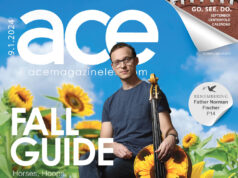Ace coverstory, 11.20.2008
Dog Loves Ellie
(from) O the Clear Moment by Ed McClanahan
[The following is excerpted from Ed McClanahan’s new book, O the Clear Moment (Counterpoint). Some of the stories included in the book first appeared in Ace. The excerpt is reprinted with the permission of the author. He will be reading and signing at Morris Book Shop on November 29, 2008]
On Labor Day weekend of 1948, my parents and I moved from Brooksville, Kentucky, population seven hundred, twenty miles east to the Ohio River town of Maysville, population seven thousand. I had arrived at last in the Celestial City. I was just a month shy of 16, an about-to-be-sophomore at my new school, Maysville High. I stood six feet, two inches tall—a considerable height in them days, kids—and weighed 147 pounds; a year and a half ago, I’d been five-feetfive— and weighed 147 pounds. It was rumored, quite incorrectly, that I was gonna be a helluva basketball player.
Secretly, I was afraid of my new height; it gave me vertigo. During the first week of school, when I was also at the dizzying height of New Kid popularity, I made friends with a junior named Gene Manley, a jittery, bespectacled, round-chinned little guy whom I thought was just unutterably cool. Well damn, he was unutterably cool; he played drums in the school band, he dated cheerleaders, and best of all, he drove this nifty little 32 Ford roadster, a mustard-yellow ragtop with painted-on crimson flames blazing back from the radiator, a rumble seat, foxtails, ahoo-gah horn…a flivver straight out of Archie and Jughead.
Talk about cool! On the Friday night of my very first week in Maysville, when I somehow insinuated myself into Gene’s rumble seat—up front, riding shotgun, was an equally cool trumpet player named Johnny Gantley (think Ray Anthony! think Young Man with a Horn!)—I was, oh my, elevated beyond imagination.
Now I was already familiar with Maysville’s many ornamental features, and the one that had always most impressed me was the bridge, that lacy, graceful, mile-long silver arc with twin spires spanning the broad Ohio to the little community of Aberdeen, which, according to my information, consisted solely of roadhouses, beer joints, and similar wholesome attractions. Over the next few years, I would become as intimate with that bridge and the interesting diversions at its other end as I am, nowadays, with the route to my refrigerator. I knew only that every time Gene and Johnny and I putt-putted along East Third Street in Gene’s flivver, past the sign pointing to Ohio, I experienced an unsettling little premonition that if I ever crossed that bridge for real, there might be no coming back.
Along about ten o’clock, on our umpty-umpth tour of East Third Street, we discovered that the entry to the bridge was blocked by a fire engine and two police cars—the entire fleet, basically, of Maysville’s emergency response rolling stock—all with their spotlights trained on the near spire of the bridge.
What was going on, it turned out, had begun one night exactly a month ago, when a notorious Maysville bon vivant named Wild Bill Dugan had clambered drunkenly but intrepidly up—and up, and up—the swooping catwalk to the very peak of the spire, 150 vertiginous feet or so above the murky waters, before the cops and firemen hauled him down. They gave him thirty days for public drunkenness and disorderly conduct—and tonight, the minute they let him out, he had scurried straight back up, to finish off the remains of the fifth of gin he’d stashed up there…exactly one month ago.
But that was actually my second introduction to the high life that awaited me in cosmopolitan, metropolitan Maysville, home of the famous Browning Manufacturing Company—which was merely the World’s Largest Pulley factory, you understand—and the soon-to-be-famous Rosemary Clooney and the already famous Maysville High basketball team, the Bulldogs.
Having started life in Brooksville, where hatred for Bulldogs was like mother’s milk, I grew up a loyal Brooksville Polar Bear. (Hey, I made the junior high team! I averaged eight points…a season!) In small-town Kentucky in those years, high school basketball was assumed to be one of the pillars of Western Civilization—or perhaps it was the other way around. The Polar Bears came by their name honestly, the original Brooksville teams having played their first few seasons in an unheated tobacco warehouse. Later in the early 1920s, the heyday of girls’ basketball, my own mother and several of her sisters were star Polar Bears in Brooksville High’s brand-new basketball palace, a modest little brick outbuilding with a playing court hardly bigger than a Ping-Pong table, the same gym I too would play in, utterly without distinction, twenty years hence. Girls’ basketball, stifled by the imposition of a plethora of dispiriting rules intended to “effeminize” (or, if you prefer, “demasculinize”) the sport, had by the 1940s been dropped by most Kentucky schools, including Brooksville High. Meanwhile, the boys’ version of the game had become more popular than God, and the Polar Bears, despite their meager home-court circumstances, had an honorable—indeed a glorious—history: In 1939 (led by Mooney and Marvin Cooper (top guns of the sixteen (!) fabled Cooper brothers, they won the state championship, a Cinderella accomplishment of Hoosiers proportions; and subsequent Coopers and Cooper cousins beyond number—Earl, Clyde, Dale, John Foster, the Yelton Boys, et al.—had kept the Polar Bears in contention in the Tenth Region ever since.
But Maysville strode the Tenth like a very Yao Ming throughout the 1940s and the Bulldogs were in the state tournament almost every year; in 1947 they won it all, and in ‘48, just six months before we moved to town, they were runnersup. I, meanwhile, had largely been a plump, bespectacled little meatball plugging along in Brooksville, twenty miles down the road, striving with all my pudgy, ineffectual might to hang onto my seat at the far end of the junior high team bench— until, in the summer before my freshman year, the growth spurt struck me like Captain Marvel’s transmogrifying bolt of lightning, and suddenly, unaccountably, I was looking down on people I’d long been in the habit of looking up to.
This flabbergasting development assured me of a spot in the junior high Polar Bears starting lineup—I was, after all, the tallest kid on the team—but did little to enhance my skills: I started every game that season…and barely eked outmy annual eight points.
The truth is, Brooksville was deeply conflicted about Maysville, which boasted, just a short Long Dog ride away, all too many of the amenities we rustics hardly dared to dream of, such as a public swimming pool worthy of Esther Williams and a dime store and the White Light nickel-burger stand and Schine’s Russell Theatre (a gorgeous arabesque fantasy with a statuette of a seminude houri in the lobby) and Kilgus’s Drugstore (where, if you were quick about it, you could sneak a peek at an astonishing little Readers’ Digest-sized periodical called Sexology, in whose pages were displayed such pornopological images as a close-up of a certain primitive work of female body sculpting called the Hottentot Apron— an image so arresting that it vividly endures in my memory even now, six decades later). There was even, rumor had it, a real live two-dollar lady of the evening, if you knew how to find her. It was enough to turn many a Brooksville boy’s head…. and mine was already swiveling like a klieg light.
From the Brooksville point of view, Maysville would’ve been the fabled City on the Hill, were it not that, topographically speaking, it was the other way around. Brooksville stands at the highest point of ground in Bracken County—its courthouse clock and water tower (both of which I have scaled, by the way) are visible for miles around—whereas Maysville crawls along the banks of the Ohio, three miles long and only six streets deep. River Rats, we called ‘em, masking our envy with disdain. In Brooksville, we knew for a fact that the wily Maysville coach Earle Jones, Evil Genius of the Hardwood, had snatched the great Kenny Reeves, one of the best players in the state during the mid-1940s, away from humble circumstances over in Ohio somewhere, and was paying him untold sums of money to play for Maysville, just so those mangy Bulldogs could routinely have their waywith our Polar Bears three times a year.
For the 1947-48 season, my freshman year, Brooksville retaliated by importing a hulking, menacing
center named Tony Maloney, a quasi-legal transplant from an upstate orphanage whose play was brutish enough to have left at least one opposing center in tears. (Tony’s fate was to become the model for Monk McHorning, the title character of—you guessed it—that widely acclaimed novel The Natural Man.) But not even Tony could roll back the annual tide of humiliation; Maysville had dispatched us handily, as usual, in the regional, and then almost won the state championship
for the second straight time.
Now my mom and dad were just as whacked out about basketball as everyone else was (and is) in our enlightened state, so every year they took me with them to Louisville for the Sweet Sixteen (as the state tournament was inevitably called), which meant that every year I was allowed, on the grounds of cultural enrichment, to cut three days of school and have my own room in the Brown Hotel and run around loose in downtown Louisville and watch a lot of great high school basketball. And every year the Bulldogs, having once again eliminated the hapless Polar Bears in the regional tournament, showed up in Louisville with the classiest teams and the most fetching cheerleaders in the Commonwealth—so that, over time, my favorite quadrupeds and secret heroes (don’t breathe a word of this in Brooksville) had become not Polar Bears but Bulldogs—Kenny Reeves and Buddy Gilvin and Buddy Shoemaker and Gus Stergeos and Elza Whalen and Emery Lacey and the Tolle brothers, Fats and Shotsie, and most of all, in the 1947 Sweet Sixteen, a pair of eighth-graders the sportswriters had nicknamed Dog and Como, who were just my age and were already, in my personal pantheon of demigods, international celebrities.
So Labor Day of 1948, the day my folks and I moved to Maysville, was a watershed in my life. That very day I changed my name, for ever and ever, from “Sonny,” the diminutive cognomen by which I’d been known (if at all) in Brooksville, to the relatively Brobdingnagian “Eddie,” as befitted my new height; and that very evening a nice old lady of our acquaintance fixed Tall Eddie up with Carla Browning, of the Browning Pulley Works Brownings, and Carla and I went to a movie at the Russell Theatre and then to Kilgus’s Drugstore for Cokes, and right there on Kilgus’s corner, Carla introduced me to…omigawd, it’s…Dog and Como!
My apostasy was complete. Go Bulldogs! A few months earlier I couldn’t have dreamed that these two paladins of the hardwood (I myself was an aspiring sportswriter, and that sort of language was my soul’s own music) would soon become not just my classmates, but also my running mates and even, for one brief, inglorious season, my teammates, fellow Bulldogs. ■
Ed McClanahan will be reading and signing O the Clear
Moment at Morris Book Shop on Saturday, November 29.
ACE Weekly November 20, 2008 page 7
YOU MIGHT ALSO LIKE
Author Ed McClanahan’s New Kickstarter Project, June 1 2012
Ed McClanahan Reader Hits Shelves, Ace coverstory, October 11 2011
In Memory of James Baker Hall, Ace coverstory July 1, 2009
A Long Strange Trip: Ed McClanahan Turns 70. Ace coverstory October 10, 2002
Old Hippie Gets New Hip, by Ed McClanahan Ace coverstory Nov 29, 2001
The Congress of Wonders, Filmmaking in Lexington November 1994
Ed McClanahan and Little Enis, the KET Signature Series April 1994







